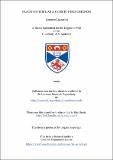Files in this item
Plato on time as a cosmic phenomenon
Item metadata
| dc.contributor.advisor | Sattler, Barbara M. | |
| dc.contributor.author | Lazzarini, Lorenzo | |
| dc.coverage.spatial | [13], 150 p. | en_US |
| dc.date.accessioned | 2020-05-18T12:16:39Z | |
| dc.date.available | 2020-05-18T12:16:39Z | |
| dc.date.issued | 2020-07-27 | |
| dc.identifier.uri | https://hdl.handle.net/10023/19958 | |
| dc.description.abstract | The thesis presents an original interpretation of the account of time in the Timaeus (37c6-39e2), arguing that time in Plato is best conceived of as a cosmic phenomenon. In Part I, my view is contrasted in crucial respects with the consensus reading, that focuses on the metaphysical definition (time is a moving image of eternity, 37d5) and downplays the importance of the cosmos and the planets in the creation of time. I reject the standard reading of αἰών as ‘eternity’ and take it instead as a feature that is essential to the model qua living being. It follows that the creation of time – being the image of αἰών – is essential to the cosmic living being. Time, however, is best defined as a cosmic phenomenon, because it is constituted by the living motion of the cosmos and identified with the visible revolutions of the planets. In the continuation of the thesis, I examine two essential aspects of Plato’s account that need further enquiry – life and structure. In Part II I focus on the semantic history of αἰών and argue that in Plato, αἰών acquires a paradigmatic function in relation to time, while still retaining the core of its traditional meaning as ‘lifespan’. In fact, αἰών and time are both defined by Plato as totalities of life, although αἰών consists in an undivided unity, whereas time is structured in sequences of parts composing a whole. In Part III I focus on how the planets make the periods of the cosmic soul visible and, as a consequence, display the enumerable structure of time. That structure consists in fact in the visible patterns of changing configurations the planets display. In doing so, they mark out sequences of units, whose optimality makes time the best instantiation of number in the physical world. | en_US |
| dc.language.iso | en | en_US |
| dc.publisher | University of St Andrews | |
| dc.rights | Creative Commons Attribution-NonCommercial-NoDerivatives 4.0 International | * |
| dc.rights.uri | http://creativecommons.org/licenses/by-nc-nd/4.0/ | * |
| dc.subject | Plato | en_US |
| dc.subject | Ancient philosophy | en_US |
| dc.subject | Greek philosophy | en_US |
| dc.subject | Philosophy of time | en_US |
| dc.subject | Philosophy of nature | en_US |
| dc.subject | Cosmos | en_US |
| dc.subject | Time | en_US |
| dc.subject | Cosmology | en_US |
| dc.subject | Timaeus | en_US |
| dc.subject | Aion | en_US |
| dc.subject | Life | en_US |
| dc.subject | Heavenly bodies | en_US |
| dc.subject | Planets | en_US |
| dc.subject | Number | en_US |
| dc.subject.lcc | B398.T55L2 | |
| dc.subject.lcsh | Plato. Timaeus | en |
| dc.subject.lcsh | Time--History--To 1500 | en |
| dc.subject.lcsh | Cosmology--Early works to 1800 | en |
| dc.title | Plato on time as a cosmic phenomenon | en_US |
| dc.type | Thesis | en_US |
| dc.type.qualificationlevel | Doctoral | en_US |
| dc.type.qualificationname | PhD Doctor of Philosophy | en_US |
| dc.publisher.institution | The University of St Andrews | en_US |
| dc.identifier.doi | https://doi.org/10.17630/10023-19958 |
The following licence files are associated with this item:
This item appears in the following Collection(s)
Except where otherwise noted within the work, this item's licence for re-use is described as Creative Commons Attribution-NonCommercial-NoDerivatives 4.0 International
Items in the St Andrews Research Repository are protected by copyright, with all rights reserved, unless otherwise indicated.


